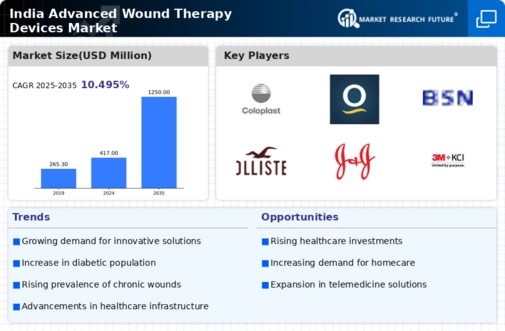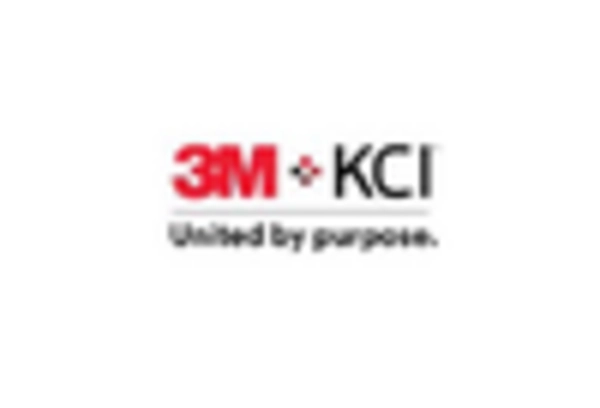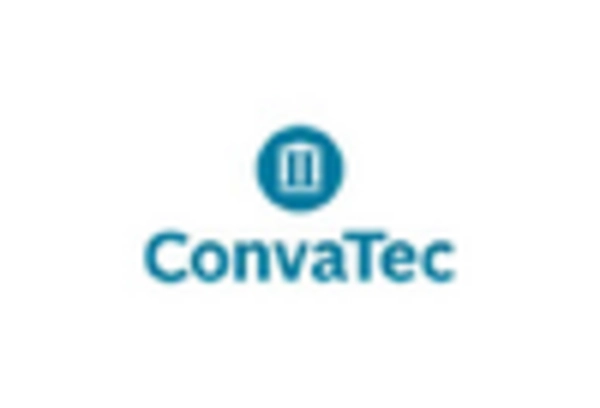Rising Healthcare Expenditure
India's healthcare expenditure has been on an upward trajectory, which positively influences the advanced wound-therapy-devices market. The government has increased its focus on healthcare infrastructure, with plans to allocate approximately 2.5% of GDP to health by 2025. This increase in funding is likely to enhance access to advanced wound care technologies, as hospitals and clinics invest in modern devices to improve patient care. Furthermore, the growing awareness of advanced wound management techniques among healthcare professionals is expected to drive demand for innovative products. As a result, the advanced wound-therapy-devices market may witness a surge in adoption rates, particularly in urban areas where healthcare facilities are expanding.
Supportive Government Policies
Supportive government policies aimed at enhancing healthcare access and quality are likely to bolster the advanced wound-therapy-devices market in India. Initiatives such as the Ayushman Bharat scheme, which aims to provide health insurance coverage to millions of citizens, may facilitate access to advanced wound care treatments. Furthermore, the government is actively promoting the development and manufacturing of medical devices within the country, which could lead to increased availability of advanced wound-therapy-devices. As a result, healthcare facilities may be more inclined to invest in these technologies, thereby driving market growth. The advanced wound-therapy-devices market stands to gain from these favorable policies, which aim to improve overall healthcare outcomes.
Growing Awareness of Wound Care
There is a notable increase in awareness regarding wound care management among both healthcare professionals and patients in India. Educational initiatives and training programs are being implemented to inform stakeholders about the benefits of advanced wound-therapy-devices. This heightened awareness is likely to lead to better wound care practices and increased adoption of advanced technologies. As patients become more informed about their treatment options, they may actively seek out advanced wound care solutions, thereby driving demand in the market. The advanced wound-therapy-devices market is expected to benefit from this trend, as healthcare providers respond to the growing need for effective wound management solutions.
Increasing Geriatric Population
The advanced wound-therapy devices market is likely to experience growth due to the increasing geriatric population. As individuals age, they become more susceptible to chronic wounds, such as diabetic ulcers and pressure sores. According to government data, the population aged 60 and above is projected to reach 300 million by 2050, which represents a significant portion of the overall population. This demographic shift necessitates advanced wound care solutions to manage complex wounds effectively. The demand for specialized devices, such as negative pressure wound therapy systems and bioengineered skin substitutes, is expected to rise as healthcare providers seek to improve patient outcomes. Consequently, the advanced wound-therapy-devices market is poised for expansion, driven by the need to cater to the unique requirements of the elderly population.
Technological Innovations in Wound Care
Technological innovations are transforming the advanced wound-therapy-devices market in India. The introduction of smart wound dressings equipped with sensors that monitor healing progress and deliver medication is gaining traction. These advancements not only enhance patient comfort but also improve clinical outcomes by providing real-time data to healthcare providers. Additionally, the integration of telemedicine in wound care management allows for remote monitoring and consultations, which is particularly beneficial in rural areas with limited access to specialized care. As these technologies continue to evolve, they are likely to drive the growth of the advanced wound-therapy-devices market, as healthcare providers seek to adopt cutting-edge solutions to enhance patient care.

















Leave a Comment